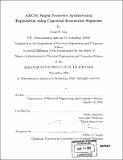AXCIS : rapid processor architectural exploration using canonical instruction segments
Author(s)
Liu, Rose F. (Rose Frances)
DownloadFull printable version (6.227Mb)
Alternative title
Rapid processor architectural exploration using canonical instruction segments
Other Contributors
Massachusetts Institute of Technology. Dept. of Electrical Engineering and Computer Science.
Advisor
Krste Asanović.
Terms of use
Metadata
Show full item recordAbstract
In the early stages of processor design, computer architects rely heavily on simulation to explore a very large design space. Although detailed microarchitectural simulation is effective and widely used for evaluating different processor configurations, long simulation times and a limited time-to-market severely constrain the number of design points explored. This thesis presents AXCIS, a framework for fast and accurate early-stage design space exploration. Using instruction segments, a new primitive for extracting and representing simulation-critical data from full dynamic traces, AXCIS compresses the full dynamic trace into a table of canonical instruction segments (CIST). CISTs are not only small, but also very representative of the dynamic trace. Therefore, given a CIST and a processor configuration, AXCIS can quickly and accurately estimate performance metrics such as instructions per cycle (IPC). This thesis applies AXCIS to in-order superscalar processors, which are becoming more popular with the emergence of chip multiprocessors (CMP). For 24 SPEC CPU2000 benchmarks and all simulated configurations, AXCIS achieves an average IPC error of 2.6% and is over four orders of magnitude faster than conventional detailed simulation. (cont.) While cycle-accurate simulators can take many hours to simulate billions of dynamic instructions, AXCIS can complete the same simulation on the corresponding CIST within seconds.
Description
Thesis (M. Eng.)--Massachusetts Institute of Technology, Dept. of Electrical Engineering and Computer Science, 2005. Includes bibliographical references (p. 73-74).
Date issued
2005Department
Massachusetts Institute of Technology. Department of Electrical Engineering and Computer SciencePublisher
Massachusetts Institute of Technology
Keywords
Electrical Engineering and Computer Science.